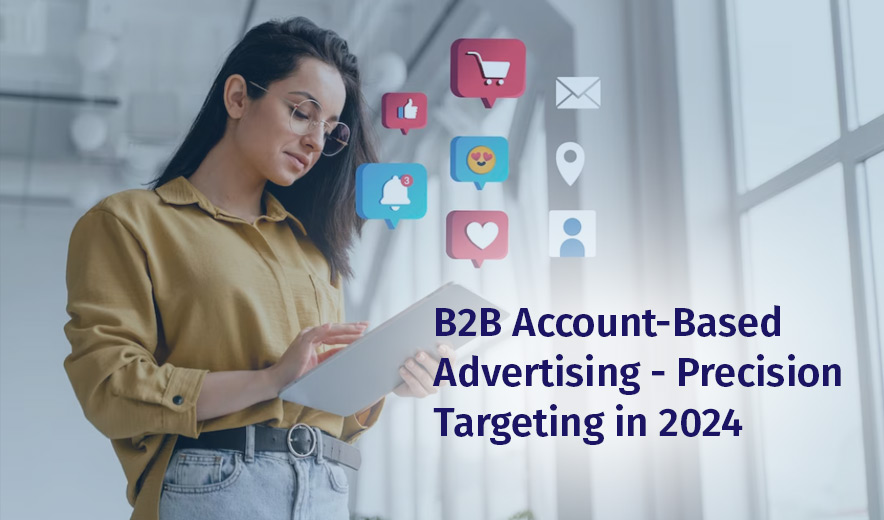Account-based advertising (ABA) is a targeted approach within B2B marketing that involves tailoring campaigns to specific high-value accounts rather than a broad audience. In contrast to traditional marketing, which often focuses on lead generation and individual prospect conversion, ABA treats individual accounts as distinct markets. The strategy involves selecting a handful of key accounts that align with a company’s ideal customer profile, considering factors such as company size, industry, and revenue.
A fundamental aspect of ABA is the customization of content and messaging. Unlike mass marketing efforts, ABA relies on crafting highly personalized content that resonates specifically with the selected accounts. This personalization extends to various channels, including digital advertising, email marketing, social media, and even direct mail. The goal is to engage decision-makers within the targeted accounts with messages that address their unique needs and challenges.
Crucially, a successful ABA requires close collaboration between the sales and marketing teams. Both departments must work together to identify target accounts, develop personalized content, and ensure a cohesive approach to engaging with prospects. This alignment is essential for maximizing the efficiency of the overall sales process and optimizing the impact of marketing efforts.
The relevance of account-based advertising in the B2B context is underscored by its focus on quality over quantity. In B2B scenarios where each customer represents a significant value, concentrating efforts on a select group of high-potential accounts makes strategic sense. This approach is particularly valuable when dealing with complex sales cycles and intricate decision-making processes within target organizations.
Moreover, ABA contributes to improved alignment with sales goals. By jointly identifying, targeting, and pursuing key accounts, marketing, and sales teams can work in tandem to enhance the overall effectiveness of their strategies. The collaborative nature of ABA fosters better communication and cooperation between these traditionally separate functions.
The benefits of ABA extend to higher conversion rates. Through the personalization of marketing efforts, the strategy increases the likelihood of capturing the attention and interest of decision-makers within the targeted organizations. This personalized engagement, tailored to the specific needs and pain points of the accounts, enhances the chances of converting prospects into customers.
While ABA may involve higher upfront costs due to the personalized nature of campaigns, it often leads to improved return on investment (ROI). By concentrating resources on accounts with the highest potential for revenue generation, companies can optimize their marketing spend and achieve better results.
In essence, account-based advertising emerges as a strategic and personalized approach in B2B marketing, emphasizing the significance of quality targeting, collaboration between sales and marketing, and the customization of content to engage high-value accounts effectively.
Targeting Strategies
Advanced targeting tactics in precision advertising involve leveraging sophisticated methods to reach highly specific audience segments. These strategies go beyond basic demographics and location targeting, delving into behavioral, contextual, and predictive targeting. The goal is to maximize the relevance of advertisements for individuals, thereby increasing the likelihood of engagement and conversion. Here are some advanced targeting tactics.
Behavioral Targeting
Behavioral targeting involves analyzing users’ online behavior to understand their interests, preferences, and purchase intent. This could include tracking website visits, clicks, and search queries. Advertisers can then serve ads based on these observed behaviors, ensuring that the content aligns with the user’s demonstrated interests.
Contextual Targeting
Contextual targeting focuses on placing ads in environments that are contextually relevant to the content being consumed. This strategy considers the context of a webpage or app to ensure that the ad is displayed in a context that enhances its relevance. For example, an ad for sports equipment might appear on a website covering sports-related content
Predictive Targeting
Predictive targeting involves using machine learning algorithms and data analysis to predict future user behavior and preferences. By analyzing historical data, advertisers can identify patterns and trends, allowing them to anticipate the needs and interests of users. This enables more accurate targeting based on predicted behaviors.
Lookalike and Similar Audiences
Advertisers can create lookalikes or similar audiences based on the characteristics of their existing customer base. Platforms analyze the attributes of current customers and identify users who share similar traits, behaviors, or interests. Ads are then targeted at these new audiences, increasing the chances of reaching potential customers with similar profiles.
Remarketing/Retargeting
Remarketing involves targeting users who have previously interacted with a brand but did not convert. Ads are shown to these users as they browse other websites or social media platforms. This serves as a reminder and encourages users to return and complete a desired action, such as making a purchase.
As for the impact on conversion rates, precise targeting has been shown to significantly enhance advertising effectiveness. When ads are relevant to a user’s interests and needs, they are more likely to capture attention and prompt action. The use of advanced targeting tactics often results in higher engagement rates, lower bounce rates, and increased conversion rates compared to broad, untargeted campaigns.
The accuracy of targeting is measured by metrics such as click-through rates (CTR), conversion rates, and return on ad spend (ROAS). A well-targeted campaign should not only drive traffic but also lead to meaningful actions, such as completing a purchase or filling out a form. Analyzing these metrics provides valuable insights into the success of the targeting strategy and allows advertisers to optimize their campaigns for better performance. Ultimately, precision advertising aims to deliver the right message to the right audience at the right time, maximizing the efficiency and impact of digital advertising efforts.
Personalization and Customization
Personalization and customization are integral components of successful targeted advertising, especially when tailoring campaigns for specific accounts. Here are insights into how personalization and customization can be implemented, along with case studies showcasing their impact
Tailored Messaging
Personalized advertising for targeted accounts involves crafting messages that resonate with the specific needs and challenges of each account. This may include addressing pain points, offering solutions tailored to the industry, or highlighting how the product/service meets the unique requirements of the business.
Account-Specific Content
Develop content that speaks directly to the targeted account. This can include creating case studies or success stories featuring similar businesses, and showcasing how your product or service has provided value. Account-specific content helps establish a deeper connection and demonstrates a thorough understanding of the client’s context.
Customized Visuals and Creatives
Tailor the visual elements of your ads to align with the brand aesthetics of the targeted account. This can include using the company’s logo, and colors, or even incorporating personalized imagery that resonates with the industry or business niche.
Dynamic Content
Implement dynamic content that adapts based on the viewer’s behavior, preferences, or demographics. For example, an ad might showcase different product features based on the industry of the targeted account, ensuring that the most relevant information is presented to the viewer.
Personalization and customization in advertising are powerful tools for engaging targeted accounts. As the digital landscape continues to evolve, incorporating personalization into advertising strategies will remain a key factor in building meaningful connections with target audiences.
Measuring Account-Based Advertising Success
Measuring the success of account-based advertising (ABA) involves assessing various key metrics that provide insights into the performance and impact of your campaigns. Here are key metrics for evaluating the effectiveness of account-based advertising:
Key Metrics for Account-Based Advertising
Account Engagement
Measure how actively the targeted accounts are engaging with your content. This includes tracking website visits, content downloads, and other interactions that indicate interest and involvement.
Click-Through Rate (CTR)
CTR measures the percentage of people who click on your ad after seeing it. A higher CTR indicates that your ad resonates with the target audience and drives interest.
Conversion Rates
Track the percentage of clicks that result in a desired action, such as filling out a form, downloading a resource, or making a purchase. Conversion rates provide insights into the effectiveness of your campaign in driving meaningful outcomes.
Pipeline Influence
Assess the impact of ABA on the sales pipeline. Track how ABA activities contribute to progressing leads through the sales funnel and converting them into opportunities.
Deal Velocity
Measure the speed at which deals progress from one stage to another in the sales cycle. ABA should ideally accelerate the deal velocity by efficiently engaging high-value accounts.
Return on Investment (ROI)
Calculate the ROI of your ABA efforts by comparing the revenue generated from targeted accounts to the cost of the advertising campaign. A positive ROI indicates that the campaign is delivering value.
Customer Acquisition Cost (CAC)
Evaluate the cost of acquiring a customer through ABA. Compare this cost to the lifetime value of a customer to ensure that the investment in ABA is sustainable and profitable.
Account-Based Marketing (ABM) Alignment
Assess the alignment between sales and marketing teams in executing ABM strategies. Close collaboration between these teams is crucial for a successful ABA.
Industry Benchmarks for Precision Advertising
Click-Through Rate (CTR)
Benchmark CTR against industry averages. While benchmarks can vary by industry, a higher-than-average CTR indicates effective targeting and engagement.
Conversion Rates
Industry benchmarks for conversion rates depend on the specific goals of the campaign and the industry. Benchmarking against similar companies can provide insights into the effectiveness of your conversion strategies.
Engagement Rates
Track engagement rates on different channels and compare them to industry benchmarks. This includes email open rates, social media engagement, and other relevant metrics.
ABM Maturity
Assess the maturity of your ABM program compared to industry benchmarks. Mature ABM programs typically demonstrate higher personalization and integration with sales efforts.
Deal Acceleration
Evaluate how quickly deals progress through the pipeline compared to industry averages. Faster deal acceleration is often a sign of effective ABA strategies.
Customer Lifetime Value (CLV)
Compare your CLV to industry averages to ensure that the lifetime value of customers acquired through ABA justifies the associated costs.
ABM Technology Adoption
Assess the adoption of ABM technology within your industry. Benchmarking against industry standards can help you stay competitive and ensure that you’re leveraging the latest tools for precision advertising.
It’s important to note that benchmarks can vary by industry and company size, so it’s advisable to consider the specific context of your business when evaluating the success of account-based advertising efforts. Regularly reviewing and adjusting your metrics based on campaign goals and industry trends will help optimize the effectiveness of your ABA strategies over time.
In conclusion, as we step into the realm of B2B marketing in 2024, the significance of Account-Based Advertising (ABA) becomes increasingly pronounced. ABA, with its emphasis on precision targeting and customization, offers a strategic departure from traditional marketing approaches. By treating individual high-value accounts as unique markets, tailoring content, and fostering collaboration between sales and marketing teams, ABA emerges as a potent tool for navigating the complex landscape of B2B marketing.
The targeting strategies discussed in this blog, ranging from behavioral and contextual targeting to predictive targeting and creating lookalike audiences, underscore the evolution of advertising precision. In the competitive digital landscape, these advanced tactics go beyond demographics, ensuring that ads reach highly specific audience segments, maximizing relevance, engagement, and ultimately, conversion rates.
Furthermore, personalization and customization stand out as crucial components in the success of targeted advertising, particularly when crafting campaigns for specific accounts. Tailored messaging, account-specific content, customized visuals, and dynamic content collectively build meaningful connections with target audiences, amplifying the impact of advertising efforts.
Measuring the success of ABA involves a comprehensive evaluation of key metrics, ranging from account engagement and click-through rates to conversion rates, pipeline influence, and return on investment. Understanding industry benchmarks for precision advertising allows businesses to gauge their performance in comparison to peers, ensuring continuous optimization of ABA strategies.
As we navigate the ever-evolving landscape of B2B marketing, Account-Based Advertising stands as a beacon of strategic and personalized engagement. The fusion of advanced targeting strategies, personalization, and meticulous measurement of success positions ABA as a cornerstone for companies striving to maximize the efficiency and impact of their digital advertising endeavors in 2024 and beyond.
Be a part of our community for free and access the best resources, trends, and new technologies from peers and industry experts. You can also check out our other awesome blogs over here.





